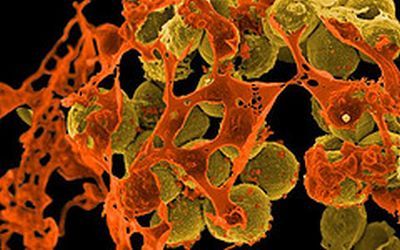MRSA Identified in U.S. Wastewater Treatment Plants
A team led by researchers at the University of Maryland School of Public Health has found that methicillin-resistant Staphylococcus aureus (MRSA) is prevalent at several U.S. wastewater treatment plants (WWTPs). MRSA is well known for causing difficult-to-treat and potentially fatal bacterial infections in hospital patients, but since the late 1990s it has also been infecting otherwise healthy people in community settings.


Scanning electron micrograph of methicillin-resistant Staphylococcus aureus (MRSA). Courtesy of NIAID
A team led by researchers at the University of Maryland School of Public Health has found that the superbug methicillin-resistant Staphylococcus aureus (MRSA) is prevalent at several U.S. wastewater treatment plants (WWTPs). MRSA is well known for causing difficult-to-treat and potentially fatal bacterial infections in hospital patients, but since the late 1990s it has also been infecting otherwise healthy people in community settings.
MRSA infections acquired outside of hospital settings--known as community-acquired MRSA or CA-MRSA--are on the rise and can be just as severe as hospital-acquired MRSA. However, we still do not fully understand the potential environmental sources of MRSA or how people in the community come in contact with this microorganism, says Amy R. Sapkota, assistant professor in the Maryland Institute for Applied Environmental Health and research study leader. This was the first study to investigate U.S. wastewater as a potential environmental reservoir of MRSA.

Reclaimed water or recycled water, is former sewage that is treated to remove solids and certain impurities, and used in landscaping irrigation. Researchers urge further study to evaluate the risk of exposure to antibiotic-resistant bacteria (MRSA) in treated wastewater.
Because infected people can shed MRSA from their noses and skin and through their feces, wastewater treatment plants are a likely reservoir for the bacteria. Swedish researchers have previously identified the presence of MRSA in WWTPs in Sweden, and this new UMD-led study confirms the presence of MRSA in U.S. facilities. The study was published in the November issue of the journal Environmental Health Perspectives.
The research team, including University of Maryland School of Public Health and University of Nebraska Medical Center researchers, collected wastewater samples throughout the treatment process at two Mid-Atlantic and two Midwestern WWTPs. These plants were chosen, in part, because treated effluent discharged from these plants is reused as reclaimed wastewater in spray irrigation activities. The researchers were interested in whether MRSA remained in the effluent.Â
They found that MRSA, as well as a related pathogen, methicillin-susceptible Staphylococcus aureus (MSSA),were present at all four WWTPs, with MRSA in half of all samples and MSSA in 55 percent.MRSA was present in 83 percent of the influent-- the raw sewage--at all plants, butthe percentage of MRSA- and MSSA-positive samples decreased as treatment progressed. Only one WWTP had the bacteria in the treated water leaving the plant, and this was at a plant that does not regularly use chlorination, a tertiary step in wastewater treatment.
Ninety-three percent of the MRSA strains that were isolated from the wastewater and 29 percent of MSSA strains were resistant to two or more classes of antibiotics, including several that the Food and Drug Administration (FDA) has specifically approved for treating MRSA infections. At two WWTPs, MRSA strains showed resistance to more antibiotics and greater prevalence of a gene associated with virulence at subsequent treatment stages, until tertiary chlorination treatment appeared to eliminate all MRSA. This suggests that while WWTPs effectively reduce MRSA and MSSA from influent to effluent, they may select for increased antibiotic resistance and virulence, particularly at those facilities that do not employ tertiary treatment (via chlorination).
Our findings raise potential public health concerns for wastewater treatment plant workers and individuals exposed to reclaimed wastewater, says Rachel Rosenberg Goldstein, environmental health doctoral student in the School of Public Health and the studys first author. Because of increasing use of reclaimed wastewater, further research is needed to evaluate the risk of exposure to antibiotic-resistant bacteria in treated wastewater.
Â
Â
Â
Â
Â
From the Derby to the Decontam Room: Leadership Lessons for Sterile Processing
April 27th 2025Elizabeth (Betty) Casey, MSN, RN, CNOR, CRCST, CHL, is the SVP of Operations and Chief Nursing Officer at Surgical Solutions in Overland, Kansas. This SPD leader reframes preparation, unpredictability, and teamwork by comparing surgical services to the Kentucky Derby to reenergize sterile processing professionals and inspire systemic change.
Show, Tell, Teach: Elevating EVS Training Through Cognitive Science and Performance Coaching
April 25th 2025Training EVS workers for hygiene excellence demands more than manuals—it requires active engagement, motor skills coaching, and teach-back techniques to reduce HAIs and improve patient outcomes.
The Rise of Disposable Products in Health Care Cleaning and Linens
April 25th 2025Health care-associated infections are driving a shift toward disposable microfiber cloths, mop pads, and curtains—offering infection prevention, regulatory compliance, and operational efficiency in one-time-use solutions.
Phage Therapy’s Future: Tackling Antimicrobial Resistance With Precision Viruses
April 24th 2025Bacteriophage therapy presents a promising alternative to antibiotics, especially as antimicrobial resistance continues to increase. Dr. Ran Nir-Paz discusses its potential, challenges, and future applications in this technology.